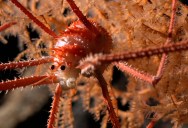The “Pristine” Marine Ecosystem That Yielded 50 Previously Unknown Species

People often refer to space as the last great frontier, but for my money, I think the ocean right here on Earth is still keeping plenty of secrets.
Proof that we don’t have to look any further than our own wet backyard to find new marvels has been found in this “pristine” ecosystem near Rapa Nui (Easter Island).
Easter Island might be most famous for its giant stone moai human statues, but I think these 50 new species of squid, fish, coals, mollusks, sea stars, glass sponges, sea urchins, crabs, and squat lobsters will give them a run for their money.
Researchers from the Schmidt Ocean Institute aboard the R/V Falkor (too) made the discovery while surveying the underwater environment off Chile’s coastline.
The Salas y Gomez Ridge is part of a chain of 110 volcanic seamounts, which is where they found the 50 species new to science.

They also discovered the deepest-known photosynthesis-dependent animal in the world: Leptoseris.
Dr. Erin Easton, Chief Scientists at Schmidt, made a statement on the find.
“The observation of distinct ecosystems on individual seamounts highlights the importance of protecting the entire ridge, not just a few seamounts.”
The expedition also made a hydrographic survey of the area’s geographical features, mapping around 78,000 square kilometers of the seafloor.

This included six as-yet undocumented seamounts.
A seamount, if you’re curious, is an underwater mountain with steep sides. They’re usually remnants of extinct volcanoes. They are typically hives of biodiversity, with their surfaces tempting for deep-sea corals, sponges, fish, cephalopods, and crustaceans.
They’re also important “pit stops” for marine creatures that migrate – whales, sea turtles, swordfish, tuna, sharks, and many more.
This is the second big discovery made by the Schmidt Ocean Institute in a few months. In February, they found 100 new species.
The region is “pristine,” according to them, which is why its unique biodiversity is so rampant.

They hope they’ll be able to have the area protected so they can keep it that way, says Dr. Javier Sellanes.
“The astonishing habitats and animal communities that we have unveiled during these two expeditions constitute a dramatic example of how little we know about this remote area. These expeditions will help alert decision-makers about the ecological importance of the areas and contribute to strengthening protection strategies within and beyond jurisdictional waters.”

There are so few reachable areas of the ocean that can be callen pristine, so I really hope the powers that be can get on board with keeping this one clean.
I can’t wait to see more of what is discovered there.
Thought that was fascinating? Here’s another story you might like: Why You’ll Never See A Great White Shark In An Aquarium

Sign up to get our BEST stories of the week straight to your inbox.




